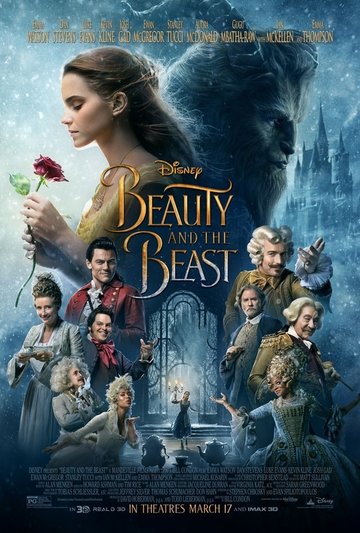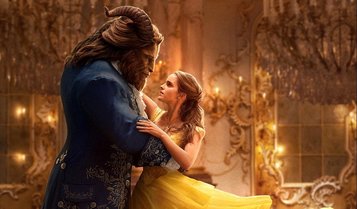Written by Kate McHargueTHIS IS THE EMERGENCY SPOILER ALERT SYSTEM...YOU ARE ADVISED TO READ AT YOUR OWN RISK... This much anticipated live-action remake of the Disney classic has received more than its fair share of publicity (both good and controversial) but at last it has hit theaters. As the little girl who watched the original animated Beauty and the Beast as much as my parents would let me, I had high hopes and slight skepticism as the theater lights dimmed and the familiar first notes of Belle’s theme began to play. This film did not disappoint. As with any film, there were moments that dragged, jokes that didn’t quite hit their marks, and characters that we could have used less of. And, if I’m honest, I’m still not sure what accent Ewan McGregor thought he was doing because it certainly wasn’t French. But as a whole, this film gives audiences everything that was beloved and enchanting from the original film while building upon that story to give us a deeper, more complex understanding of this classic fairytale. Belle is still a beauty, headstrong and kind. The Beast is still oblivious and hot-headed but capable of change. Gaston is still a total creep. And the castle’s staff/antiques are still the comedic heart the film. But in rising to the task of updating and expounding upon the story everyone knows, Disney made some incredibly smart, subtle, and inspired changes to give this tale more substance. Firstly, Belle is also an inventor in this rendition. Her father, Maurice, is a painter and a clock maker with an obvious eye for tinkering, but Belle has also picked up the trade. She hands Maurice the tools he needs before he can even ask for them and some before he even knows he needs them. She then invents a more efficient method for doing the laundry, leaving her more time to read. In this film, Belle isn’t just bookish 'with a dreamy far off look and her nose stuck in a book.' She’s an innovative thinker and desperate to put her intellect to good use. This is evident when the townsfolk destroy her laundry invention and complain that she’s teaching other young girls to read (because apparently one educated woman is bad enough). Belle’s longing for something more than a provincial life becomes less about the boring and stifling life of a young girl in a small town and more about her hunger for more knowledge and more opportunities to actually DO something with her talents. Then there’s Gaston. Anyone who saw the original film could tell you that Gaston is a conceited and petulant creep. But this film digs even deeper into what makes Gaston worthy of the title of villain. His first introduction in this rendition is just as humorous and awkward as in the original, but this time they make it all the more clear that he sees Belle only as a prize to be won rather than a woman with her own thoughts and desires. He specifically compares the other women in town to rabbits and claims that there’s no fun in hunting them because they’re not a challenge. In one line he manages to denigrate all women to the status of prey and places Belle in the dangerous position of being the prize stag that he’ll ensnare and keep as a trophy. This vile behavior only worsens with the way he treats everyone else.  The original Gaston also tries to have Maurice locked away in an insane asylum and rallies the town into a mob to kill the Beast, but this Gaston does all of this after he punches Maurice and then leaves him to be eaten by wolves. When Le Fou (Gaston’s supposed best friend) speaks out against this behavior, Gaston threatens that he’ll be next. Then in the fateful standoff between Gaston and the Beast, Gaston pleads for his life. The Beast spares him, stating clearly, 'I am not a Beast', reminding the audience who the real monster is. And in case we needed more convincing, Gaston shoots the Beast in the back… twice. In this remake, Gaston’s hyper-masculinity is shown for the toxic danger it really is. It is his blatant sense of entitlement and penchant for anger that spreads hatred and reinforces society’s tendency to shun and punish those who go against the established order. And all the while, he believes himself the hero. This film also gives us more background on our Beauty and Beast. In short, through well-timed flashbacks we learn more about how both were put on the paths that led them to one another. We learn that Belle’s mother died of the Plague in Paris which is why her father brought her to the little village where he believes she’ll be safe from the horrors of the world. Maurice has never spoken of it but Belle learns the truth and in a heart to heart with her father makes it clear that she is grateful for his protection but that she is not afraid of the dangers of the world. She is capable of facing them all head on. She is the one who can break the curse because she, like her mother, is fearless. And the Beast was not always so cruel and monstrous as he was when the Enchantress cursed him. His mother died when he was just a small boy and it was his cruel and abusive father that turned him into a 'beast.' The compassion he once had is allowed to resurface when he is once again shown the kindness he was so long denied, first by his father and then by the curse. Finally, in true Disney fashion, there are new songs that provide beautiful depth to the characters we already hold so dear. The song 'Days in the Sun' allows audiences to really feel for the other inhabitants of the castle who are as equally cursed as the Beast. They are days away from turning into inanimate objects completely and losing what humanity they had left but they still think only of helping one another and enjoying what time they do have. And in seeing this, Belle reflects on how sheltered and lonely her life has been. She is frightened of her current situation but grateful for the new experience and the way it has widened her understanding of the world and, in turn, her understanding of the Beast. The Beast is also given a new song, 'Evermore'. At first he laments at how Belle has disrupted the solitude to which he has grown accustomed and how her presence and eventual absence only makes his curse harder to bear. But he then goes on to muse on how she taught him to embrace his emotions and to enjoy the simple pleasures of life, curse or no curse. He is grateful to have met her because he has grown as a person and that is worth the pain he feels at losing her. With both of these songs, each character becomes a fully realized individual and their relationship seems less like an impossible fairytale and more like the actual love of two outcasts finding acceptance and growth in one another. This is not the first of Disney’s live action remakes but, in my opinion, it is the first that feels truly worthy of the original. Beauty and the Beast is one of the most beloved Disney films of all time, with an Oscar for Best Original Score and a Golden Globe for Best Motion Picture. The team that created this new edition had their work cut out for them and rose to the occasion marvelously. The magic of this familiar story leaps off the screen but the changes give audiences a new way to fall in love with a tale as old as time.
0 Comments
Leave a Reply. |
Archives
November 2024
|
|
© 2012-2024, Nerds That Geek LLC.
All Rights Reserved. |
uWeb Hosting by FatCow


 RSS Feed
RSS Feed